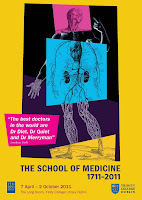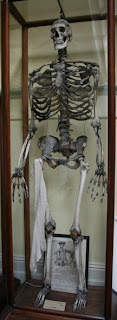300 years of medicine at Trinity

Throughout 2011 the School of Medicine at Trinity College Dublin will be celebrating its tercentenary. As part of these celebrations the TCD Long Room is hosting an exhibition entitled
'The Best Doctors in the World are Doctor Diet, Doctor Quiet, and Doctor Merryman: 300 Years of Medicine at Trinity College Dublin', which will run until October this year. The exhibition brings together some of the highlights of the Long Room's collections relating to medicine in Ireland. As the head curator said at the official launch last week, the combination of the huge time scale and the limited exhibition space meant that there was less than 2cm² to cover each of the 300 years.
The exhibition takes the visitor on a chronological progress through over three hundred years of medical history, from the sixteenth century Guild of Barber Surgeons, through the golden age of Irish medicine in the nineteenth century, to huge developments which have taken place in the twentieth century. Given the huge range of possible material the curators have selected a fascinating selection of material from a sixteenth century Irish language manuscript on the eye, the first book on dentistry published in Ireland (1686), the death mask of Jonathan Swift and the envelope in which
Dr Dorothy Stopford-Price imported the first
BCG vaccination into Ireland to be used at
Saint Ultan's Hospital.

Perhaps the most interesting item on display is the skeleton of the Irish giant, Cornelius Magrath (1736-1760), loaned for the occasion by Trinity's anatomy museum. Like
Charles Byrne, Cornelius Magrath suffered from acromegaly, a condition which resulted in him growing to seven feet in height. In his late adolescence and early twenties, Magrath toured England and Europe, exhibiting himself as a medical curiosity. In 1760 he died in Dublin, where his body was snatched by Trinity Students who dissected his corpse to try and understand the cause of his large size. Following the dissection Magrath's skeleton was preserved and has formed part of Trinity's anatomy museum ever since.
 |
| Late eighteenth century engraving of Cornelius Magrath |
Click
here for more details of the exhibition and
opening times.